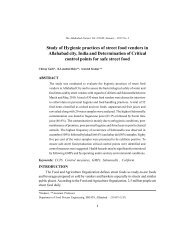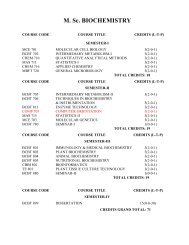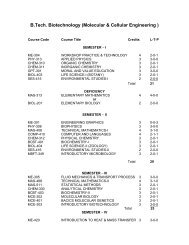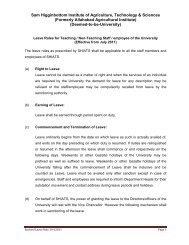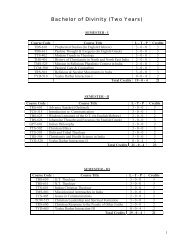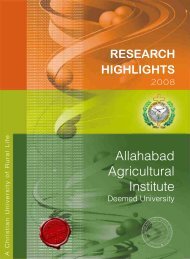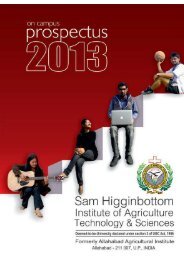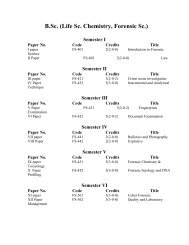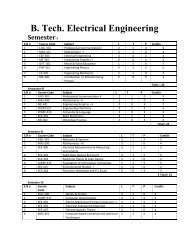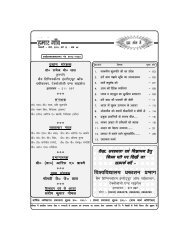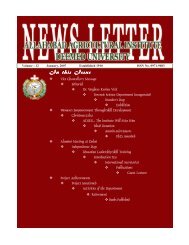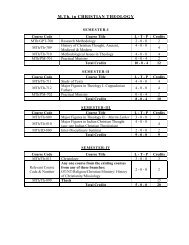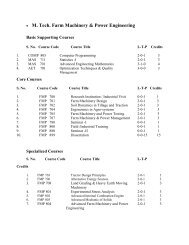7. Switch<strong>in</strong>g Theory & Logic Gates: Number systems, conversion of bases, Boolean algebra,Logic Gates, concept of universal gate, canonical forms, and m<strong>in</strong>imization us<strong>in</strong>g K-map.8. Electronic Instruments: Multimeter, CRO and its Applications.References:1. Boylestad & Nashelsky/Electronic Devices & Circuits/ PHI.2. Morris Mano/Digital Computer Design/ PHI.3. Milliman, J. Halkias/Integrated Electronics/TMH.4. Malv<strong>in</strong>o & Leach/Digital Pr<strong>in</strong>ciples & Application/List of Experiments:1. Study of Diode characteristics.2. Study of Common Base Transistor characteristics.3. Study of Common Emitter Transistor characteristics.4. Study of Half Wave Rectifier with effect of Capacitor and also calculate the ripple factor.5. Study of Full- Wave Rectifier with effect of Capacitor and also calculate the ripple factor.6. Study of Various Logic Gates.7. Study of Clipp<strong>in</strong>g and clamp<strong>in</strong>g Circuits.8. Study of C.R.O., Function generator, Multimeter.PROFESSIONAL COMMUNICATION IICourse Code LNG-303 CREDIT : 3 (3-0-0)1. <strong>Tech</strong>nical Written Communication(a) Nature, orig<strong>in</strong> and development of technical written communication.(b) Salient Features.(c) Difference between technical writ<strong>in</strong>g and general writ<strong>in</strong>g.2. Pre-requisites of Scientific and <strong>Tech</strong>nical Communication(a) Fragment sentences.(b) Parallel comparisons.(c) Elements of a series.(d) Squ<strong>in</strong>t<strong>in</strong>g construction and split <strong>in</strong>f<strong>in</strong>itive.(e) Modifiers, connectives, antecedents and clause subord<strong>in</strong>ation.(f) Dangl<strong>in</strong>g participles and gerunds.(g) Ellipsis.(h) Coherence, Unity, Chronological method, spatial method, <strong>in</strong>ductive method, l<strong>in</strong>earmethod, d<strong>edu</strong>ctive method, <strong>in</strong>terrupted method.3. Bus<strong>in</strong>ess Correspondence(a) General pr<strong>in</strong>ciples of bus<strong>in</strong>ess correspondence.(b) Ramifications of bus<strong>in</strong>ess letters.(c) Letters giv<strong>in</strong>g <strong>in</strong>structions, <strong>in</strong>quiries and answers to enquiries, compla<strong>in</strong>ts andadjustments, letters urg<strong>in</strong>g action, employment letters, application and resumes.4. Proposal Writ<strong>in</strong>g(a) Proposal: Def<strong>in</strong>itions and k<strong>in</strong>ds.(b) Division of format proposals (front matter, title page, summary/ abstract, Table ofcontents etc.)(c) Statement of request, body- statement of problem, background, scope, methodology,Advantages and disadvantages.5. Writ<strong>in</strong>g Scientific and Semi-technical Articles(a) Source material, topic sentence, literature review.(b) Tables, figures, footnotes, bibliography.
6. Study of Scientific and General Texts.(A). Prescribed text books for detailed study Arora, V.N (et. al.), Improve your writ<strong>in</strong>g (Delhi: Oxford University Press, 1981.2 Lesson No. 1.2, 1.6, 2.4, 3.5, 4.1, 4.3, 5.1, 5.4, 6.2.(B). For extended Read<strong>in</strong>g (any one of the follow<strong>in</strong>g) Orwell George, N<strong>in</strong>eteen Eighty Four (New York: Pengu<strong>in</strong>, 1984)2 Hem<strong>in</strong>gway, Ernest, The old man and the Sea, (Oxford: 1990)7.Listen<strong>in</strong>gComprehension(a).Ear-tra<strong>in</strong><strong>in</strong>g.(b). Uses of latest scientific techniques (AVR Comprehension tra<strong>in</strong>er,SRA Comprehension tra<strong>in</strong>er, SRA Comprehension Accelerator, AVR ComprehensionReteometer.)8.Read<strong>in</strong>gComprehension.(a) Scann<strong>in</strong>g method.(b) Skimm<strong>in</strong>g method.9. Phonetic Transcription10. Stresses and Intonation.References1. Sherman, Theodore A. (et al) Modern <strong>Tech</strong>nical Writ<strong>in</strong>g, New Jersey, Prentice Hall, 1991.2. Legget, Glenn (et al) Essentials of grammar and composition, Macmillan, Delhi 1994.3. Strunk, Jr. William (et al), The elements of style, Macmillan, 1987.4. Sharma, S.D A Text Book of Scientific and <strong>Tech</strong>nical Writ<strong>in</strong>g, Vikas, Delhi, 1990.ELECTRICAL ENGINEERINGCourse Code EEE-303 CREDIT : 4 (3-0-1)1. S<strong>in</strong>usoidal Steady State Circuit Analysis:Voltage, Current, S<strong>in</strong>usoidal & Phasorrepresentation.1-Phase A.C. Circuit-behavior of resistance, Inductance and Capacitance andtheir comb<strong>in</strong>ations, impedance, concept of power, power factor, series & parallel resonancebandwidthand quality factor.2. Network Theory:Introduction to basic physical laws, Network theory: Superposition,Theven<strong>in</strong>, Norton, Maximum Power transfer theorems, Star-delta transformation, Circuit theoryConcepts: Mesh and Nodal analysis.3. Three Phase Supply:Star/delta connections, l<strong>in</strong>e and phase voltage/current relations, Threephasepower and its measurement.4. Basic Instruments:Instruments for measurement of voltage, Current, power and energy:Construction, pr<strong>in</strong>ciple and application.5. Magnetic Circuit and Transformer:Magnetic circuit concept, theory and work<strong>in</strong>g pr<strong>in</strong>cipleof s<strong>in</strong>gle-phase transformer.6. Rotat<strong>in</strong>g Mach<strong>in</strong>es:Pr<strong>in</strong>ciples of energy conversion, Basic concepts of rotat<strong>in</strong>g mach<strong>in</strong>es,DC mach<strong>in</strong>es, Different types and their characteristics & applications. Elementary idea ofoperation of synchronous and <strong>in</strong>duction mach<strong>in</strong>es. S<strong>in</strong>gle-phase <strong>in</strong>duction & stepper motors,Applications.7. Power Systems:Introduction, Elements, L<strong>in</strong>e diagram, Supply systems, Power factorimprovement.Reference:1. V. Del Toro/ Pr<strong>in</strong>ciples of Electrical <strong>Eng<strong>in</strong>eer<strong>in</strong>g</strong>/ PHI.2. W.H Hayt & J.E Kennedy/ <strong>Eng<strong>in</strong>eer<strong>in</strong>g</strong> Circuit Analysis/ McGraw Hill.
- Page 1 and 2: B. Tech. Production & IndustrialEng
- Page 3 and 4: 6 ME 516 Energy Management 3‐1‐
- Page 5 and 6: Sin, orign of sin, manifestation of
- Page 7 and 8: Center of gravity, centroids of lin
- Page 9: 2. To determine the Ferrous content
- Page 13 and 14: 6. X-Rays: Origin of X-rays, Contin
- Page 15 and 16: 11. Write C program to demonstrate
- Page 17 and 18: Steam Turbines: Classification, imp
- Page 19 and 20: Theories of Failure:Various theorie
- Page 21 and 22: Environment Protection act.Air (Pre
- Page 23 and 24: Transformers:Construction, EMF equa
- Page 25 and 26: 5. Production Planning and Control:
- Page 27 and 28: Interpolation:Introduction, Errors
- Page 29 and 30: Note-1. Students may be advised to
- Page 31 and 32: Mental blocks, Removal blocks, Idea
- Page 33 and 34: Carburetion and gasoline Injection:
- Page 35 and 36: With initial review teaching of Aut
- Page 37 and 38: 2. Conventional energy resources an
- Page 39 and 40: Array, matrix, string, structure, c
- Page 41 and 42: Generals requirements, Road, tyre a
- Page 43 and 44: INTRODUCTION : Past , Present and f
- Page 45 and 46: Study of the design aspects. Fluid
- Page 47: MECHANICAL VIBRATIONCourse Code ME-



